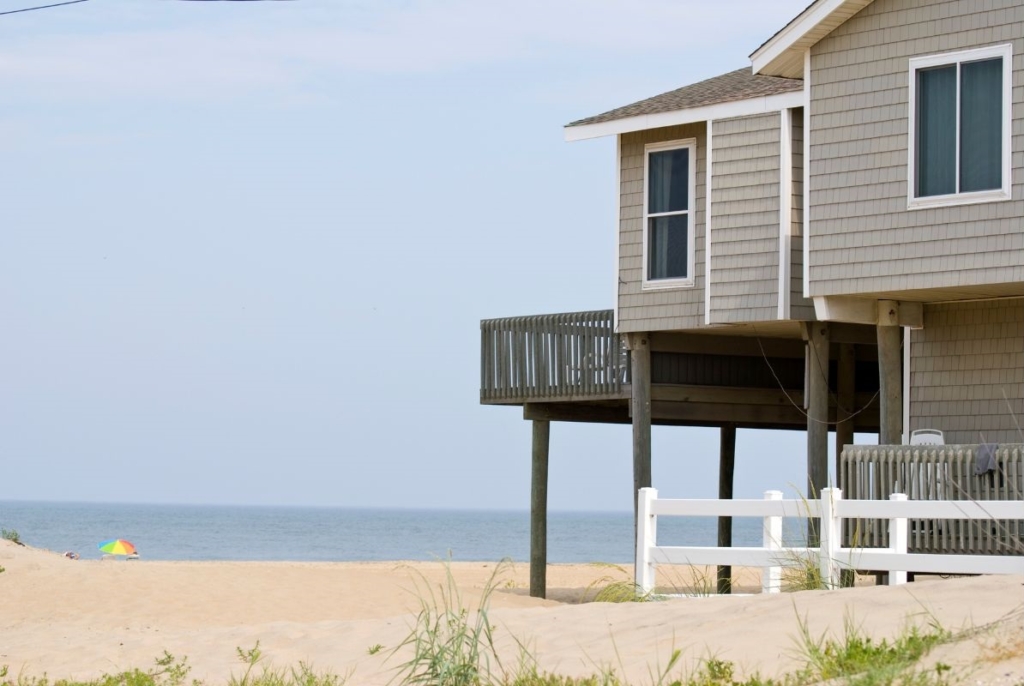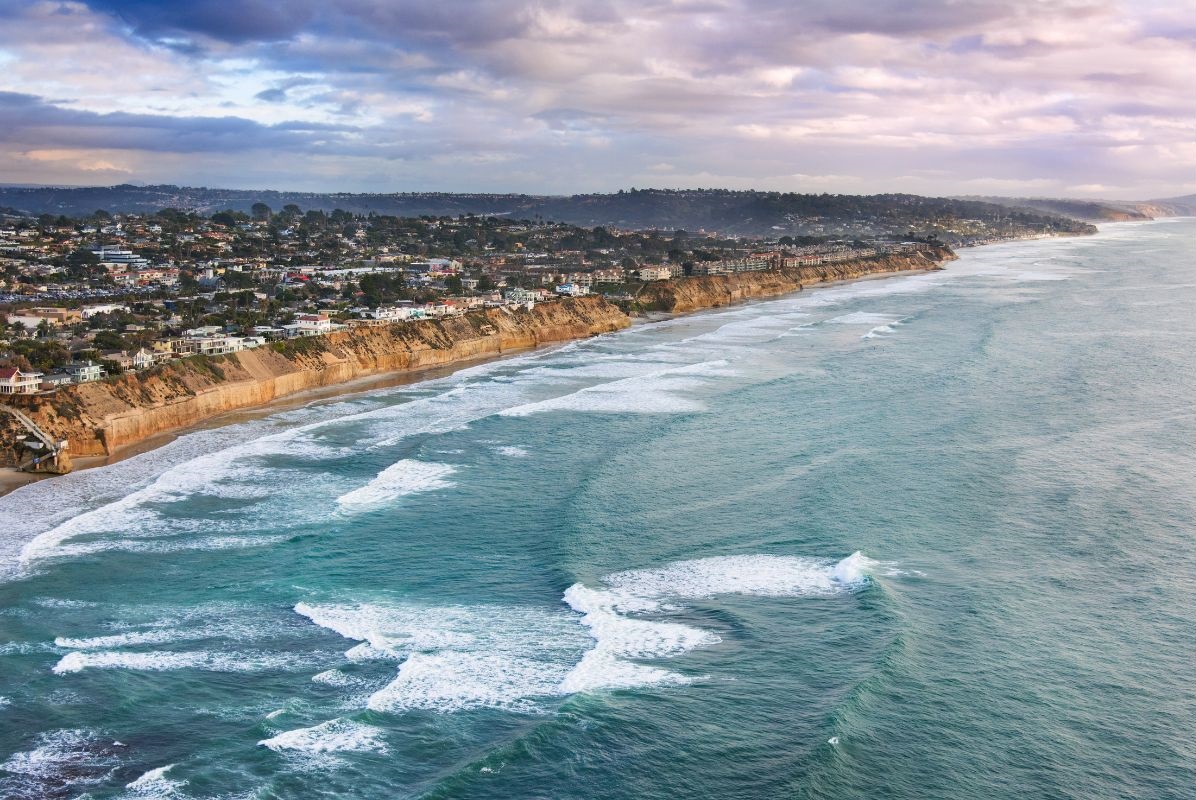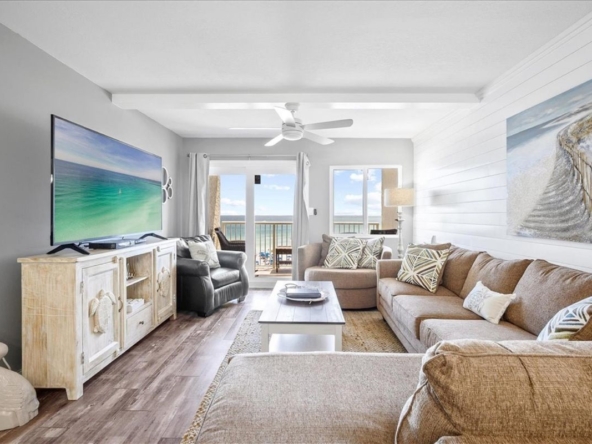The city of San Diego has enormous vacation rental income potential because it’s major tourist destination. Vacationers flock to the city not only for its magnificent location, world-class attractions, exquisite cuisine, and culture, but also for it’s beautiful year-round weather.
When it comes to weather, San Diego is considered gold standard. This city, located directly on the coast of the Pacific ocean, is famous for its mild climate, with consistent moderate temperatures throughout the year. The summers are arid and warm, but never scorching hot, while the winters are cool, wet, and partly cloudy, with average temperatures ranging from 60°F to 70°F. But, although the weather is one of major draws, it also plays an important role in how you should manage and maintain your short-term rental property. From seasonal demand trends to physical wear and tear, the weather can impact almost all aspects of running a vacation property in San Diego.
Increase Your Short-Term Rental Revenues by Leveraging Your Knowledge of Subtropical Weather
In this article, we have helpful information for short-term rental owners of beachfront homes in bluff-top property, and seaside condos and houses in Encinitas, Del Mar, Carlsbad, Oceanside, La Jolla and other hot tourist destinations in the area. Knowing how local weather affects your business operations is essential for protecting your investment and increasing your profit. Below, we will explore various ways of how coastal weather impacts vacation rentals in San Diego and how you to plan accordingly to gain maximum profits. Alternatively, you can always turn for help to professional property managers who will take care of all the responsibilities instead of you.
Table Of Contents:
1. The impact of seasonality on guest demands and booking trends
3. Selecting the right type of insurance and liability planning
4. The importance of proactive maintenance & hiring a professional property manager
5. How weather influences luxury beach properties for rent in San Diego
6. A month-to-month weather guide for coastal holiday rentals
Maximize Profits, Minimize Weather Risks with Swell Property
Swell Property is a leading real estate and vacation rental management company serving coastal North County San Diego. With deep local expertise and a hands-on approach, we specialize in maximizing rental income while preserving the long-term value of your property. From marketing and maintenance to guest relations and weather-readiness, our property manager will ensure your vacation rental performs at its best – rain or shine. Looking for expert help? Learn more about San Diego vacation rental management with Swell Property today.
The Impact of Seasonality on Guest Demands and Booking Trends
San Diego has mild, Mediterranean-style climate that significantly affects vacation rental demand. However, even though average temperatures are between 65–75°F most of the year, the guest demand fluctuates and spikes seasonally. The busiest time of year is summer (June through August), particularly for properties near popular beaches like Moonlight State beach and Swami’s in Encinitas, Tamarack State beach (Tamarack Surf beach) in Carlsbad, or Del Mar beach. Another surge in demand is seen during Spring break and holidays.
In vacation rental industry, as in travel industry, we can distinguish three different seasons:
High season (Peak season)
High season in travel is considered period with highest demand, when guests are most likely to book vacations, so the demand for short-term rentals is high. For San Diego, high season is from late May to early September, with peak season during summer holidays (June through August). Bookings are also frequent during holidays and special events. This is the time of the year when the rates are at a premium, and travelers expect superior amenities.
Profit increase potential: Use strategic pricing to maximize revenue.
Shoulder season
Shoulder season is a transitional season that falls between peak season and off season. In San Diego, shoulder season is between March and May (except March break, which is high season), and September to October. During this time the weather is mild, the crowds are fewer, and prices are lower. This is perfect time to market your property to remote workers, long-weekend travelers, or guests who are travelling on business.
Profit increase potential: Offer special promotions to attract more guests during shoulder seasons.
Low season
November through February (excluding the holidays) is considered off-season in vacation rental industry. Guest demand is low, there are no crowds and prices are at their lowest. This is the time when you have to engage various marketing and pricing strategies to maintain occupancy.
Profit increase potential: Minimum stay requirement, bundled packages, attractive discounts, flexible stays, joint promotions with local businesses.
Weather Patterns in San Diego: How to Protect Your Vacation Rental Property from Various Meteorological Conditions Specific to this Area
Weather is one of major factors that can substantially affect short-term rental business because the success of vacation rental industry heavily relies on seasonal weather conditions. If you own a coastal property you have to be aware of these patterns and be prepared for higher maintenance requirements, potential damages from severe weather, guest demand fluctuations, and property values.
Here’s a more detailed look at how rental properties are affected by weather conditions.
Humidity & salty air
The air along the Pacific Ocean has more moisture due to increased evaporation and warmer ocean temperatures. It also contains a high amount of salt, which is corrosive and accelerates deterioration of materials, especially in properties in close proximity to the ocean (within half a mile).
Key facts:
The fine ocean mist leaves salt residue behind, which corrodes metal, degrades stucco and wood, and deteriorates paints and finishes. Properties in Encinitas, Leucadia, or Del Mar are among the most vulnerable ones.
- Metal & hardware – Outdoor metal structures, railings, fences, door handles, and hinges, should be made of marine-grade stainless steel or other corrosion resistant materials to prevent rust.
- Paint and finishes – To avoid peeling, bubbling, and cracking paint, use weatherproof, salt-resistant paints for the exterior of the building.
- Doors and windows – Since salt can build up over time and degrade window tracks and locks, it’s recommended to regularly clean them with mild vinegar rinse.
- Stucco – When continuously exposed to salty air, outer layers of stucco start to crack, allowing moisture to penetrate the construction. To protect stucco surface from being eaten away by salt, apply a protective water-resistant sealer, specially formulated for coastal properties. Remember to repair any cracks or chips before applying the sealant or else you may make the situation even worse. Don’t forget to regularly inspect and clean it using mild cleaners.
- Wooden elements – High concentrations of salt combined with humidity and warm temperatures cause degradation of wood (swelling, warping, and rotting). Protect wood by applying salt-resistant coating (paint, stain, sealant), regular cleaning, and prompt repairs. Remember to occasionally reapply protective coatings.
- HVAC unit & electrical appliances – To prevent premature failure and costly repairs, protect electrical equipment and HVAC system by using corrosion-resistant materials, waterproofing electrical installations, anti-corrosion coatings, regular cleaning and maintenance.
- Outdoor fabrics – High concentration of moisture can weaken natural fibers and make them more susceptible to mold and musty odors.
Pro tip: During windy or foggy months, your cleaning checklist should include salt removal off all elements that can be damaged by salty, humid air such as windows, light fixtures, and HVAC units. Use water-repellent sprays and consider using dehumidifiers.
Marine layer, fog, and light
San Diego’s coastal towns are prone to specific atmospheric condition known as marine layer, particularly in late spring and early summer. This phenomenon is locally known as “May Gray” and “June Gloom.” It forms when cool, moist air from the Pacific Ocean collides with warmer, inland air creating persistent fog. These occurrences can potentially deter guests from visiting the area, because they expect clear skies and sunny beach weather.
Key facts:
Since vacationers are expecting sunshine, overcast skies and low visibility may lead to mixed experiences and not-so-great reviews. That’s why it’s important for visitors to be aware of these overcast conditions. In order to improve booking rates during these months, focus on adjusting interior design, focusing on exclusive amenities, unique experiences, and cooler weather benefits.
- Interior design – Opt for brighter, lighter colors to maximize natural light and to make the overall ambiance feeling cheerful and joyful.
- Outdoor area – Because reduced sunlight exposure is coupled with cooler temperatures, consider placing heaters and extra lighting for added comfort on cooler, foggy days to improve overall experience.
- Transparent listing – Ensure you are transparent about everything on your listing. You may mention marine layer in FAQs or mentioning in notes. That way the chance of guests being disappointment is minimal, and you are less likely to receive negative reviews.
Pro tip: Consider installing motion-activated lighting outdoor for improved safety and guest satisfaction.
Sand and dust storms
Although wind and sand intrusions are not that frequent in the San Diego area, they can still occur, especially during late afternoons in the winter. This phenomenon manifests when high coastal winds lift sand, causing reduced visibility, health concerns, and potentially to reduced bookings.
Key facts:
Strong winds can potentially damage fences, railings, outdoor furniture, while sand can accumulate inside properties, leading to increased maintenance needs and extra cleaning efforts to avoid guest complaints.
- Preventative landscaping techniques – Plant trees and shrubs to create windbreaks or install wind-blocking fences to reduce wind and sand intrusion. Choose native plats that will prevent soil erosion or strengthen the surface by adding a layer of surface treatments.
- Protect the entryways – Consider installing double-door vestibules, non-slip mats, and exterior rugs to keep sand out of your property. Seal any cracks around entryways and install door sweeps and screens.
- Secure outdoor items – Anchor outdoor furniture (umbrellas, chairs, tables), tools, and other items or equip the outdoor with heavy outdoor pieces to prevent damage or injuries.
- Indoors – Use air purifiers with HEPA filters to remove dust from the air and regularly change air filters. Declutter the property to minimize the amount of surfaces for sand and dust to settle. Have shoe storage installed at the door
Pro tip: Have deep cleanings of ducts and filters, several times a year, because sand can build up in filters; thus reducing system efficiency. Regularly clean metal surfaces and gutters.
Sun & UV light
In San Diego, UV index values are high due to its latitude, with highest radiation levels (11+, extreme category) occurring May through July, and lowest index values (3- 5, moderate category) during the months of January through December.
Even when it’s overcast, exposure to sun and UV lights can damage structure, roof, exterior paint, and furniture ultimately shortening your property’s life span and its value.
Key facts:
If not managed properly, UV degradation can become very costly, so ensure you take every precautionary measure to keep your investment property healthy.
- Roof – Over time, exposure to sun and UV radiation causes thermal degradation, brittleness, cracking, and discoloration of shingles, resulting in leaks, premature replacement, and negative effect on the esthetics of your property’s curb appeal. For protection, use UV-resistant coating that reflects sunlight, reduces UV light damage, and keeps temperature cooler. By applying reflective coating you will reduce energy costs, maintain property’s value, preserve curb appeal, and extend roof’s lifespan.
- Interior UV protection – Install UV-blocking window films, solar screens, or UV-blocking shades, blinds, or curtains to protect the floors and furnishings. Choose sun-resistant fabrics and periodically rotate and rearrange cushions and furniture to ensure even wear.
- Exterior finishes – UV exposure causes corrosion, discoloration, material degradation, cracking, and chipping of exterior finishes. To protect, choose paints with UV inhibitors, reseal decks with UV-resistant coating, apply UV-blocking sealants, and create shade (awnings, pergolas, strategic tree planting).
- Outdoor furniture – UV rays weaken the materials and cause discoloration, so it’s important to choose outdoor furniture made from fabrics that resist or block ultraviolet (UV) radiation, apply UV-protective coatings to wood furniture, and make shade by using umbrellas, canopies, awnings, pergolas, and trees.
Pro tip: Protect hardwood floors by using UV-resistant finish, or simply add a rug. Make sure to rotate the rug (and furniture) from time to time, especially if it’s in the ocean-facing room with large windows.
Heavy rains, storms, and water drainage
Although intense storms are not typical for this area, poorly designed drainage system can be overwhelmed by heavy rain, especially in older or bluff edge homes.
Key facts:
Proper drainage system and water management strategies are crucial if you want to avoid water damage, structural issues, electrical hazards, pest infestation, and mold and mildew growth.
- Gutters & roof – Gutters and downspouts must be regularly cleaned to prevents clogs, backups, overflow, and siding damage. Regularly inspect roof and promptly address leaks and damages to prevent water from entering the building.
- Drainage – Ensure proper drainage and prevent water from flooding the basement and from pooling near foundation, walls or doorways by grading the property to slope away from foundation. Recommended grading is 1 inch of drop for every foot away from the house.
- Landscaping – Use mulch to prevent soil erosion or install a rain gardens to manage stormwater runoff.
- Basement – In lower and subfloor areas, look for signs of mildew or water intrusion and seal cracks with waterproof compounds.
Pro tip: After every heavier rain, inspect the property thoroughly for signs of pooling, erosion, and clogged drain. This is especially applicable for properties that are near sea level.
Selecting the Right Type of Insurance and Liability Planning
When you own rental property, you face a specific set of risks, depending on where your property is located, and this directly affects what type of coverage you need and how much it will cost. For coastal properties, risks are salt damage, floods, soil erosion, and other
Facts to know:
Standard landlord insurance coverage may not cover coastal erosion or corrosion by salty air, so consider adding appropriate coverages or endorsements to have maximum protection.
- Flood insurance is vital for any coastal property because it requires more comprehensive coverage than standard homeowner’s insurance.
- Business interruption insurance can also be very helpful especially in cases when the home becomes uninhabitable due to weather-related accidents.
Pro tip: Speak to your insurance agent about the risks and how you can make your current policy meet all your needs. Your policy should be reviewed annually as conditions may change during the course of time.
The Importance of Proactive Maintenance & Hiring a Professional Property Manager
Managing a property near the coast is quite different from managing a property that is located downtown. It requires specific systems and partners who can respond quickly to weather-related issues or wear and tear.
Facts to know:
To maintain high standards of service at all times and to ensure great guest reviews, you have to partner with seasoned vendors and contractors with lots of experience.
- Find experienced contractors who are familiar with maintaining beach and coastal properties with marine exposure salt-related degradation, poor drainage systems, etc.
- Have backup experts (HVAC, roof repair) on call during months with high-rainfall rates.
- Add weather-related protocols to your guests’ manual – instruct them to close windows during strong winds, or to bring in items or decorations that could become projectiles.
Pro tip: For a complete hands-off ownership experience, hire a full-service property manager, like Swell Property, who understands all the weather-related needs of San Diego coastal short-term rentals.

How Weather Influences Luxury Beach Properties for Rent in San Diego
Even though all investment properties are subject to the effects of climate, luxury beachfront properties are different because they have more complex structures and features and their guests have higher expectations and want luxury amenities. Plus, these houses are typically located in prime locations, facing the ocean, which increases their value but also their vulnerability to weather.
Things to Know:
High-end materials and finishes (imported tile, custom metalwork) are also susceptible to salt, corrosion, and moisture, but they do cost significantly more, so it’s important to have specialized maintenance and rapid response. Guest expectations are very high at this tier, meaning even a minor issue (like a musty smell) may result in poor review or refund claim.
- Outdoor living space – Luxury beach homes with features such as infinity pools, outdoor kitchens with stainless steel appliances, stone surfaces, designer outdoor furniture, or rooftop decks require continuous care and attention, because they are constantly impacted by the weather.
- Smart home system – All built-in electronics (motorized shades, surround sound, entertainment equipment) must be adequately protected from humidity and salt damage.
- High-value furnishings & decorations – Remember to keep them away from ocean-facing windows and shield them by using museum-grade glass or by applying a UV-protection on windows.
Pro tip: If you own a luxury beach rental in San Diego, schedule inspections at least twice a month and keep a detailed service log to maintain property’s value, improve guests’ experience, prevent unexpected costs, and turn one-time guests into loyal customers.
A Month-to-Month Weather Guide for Coastal Holiday Rentals
San Diego is famous for its gorgeous weather and mild Mediterranean-like climate; however, weather conditions may substantially shift throughout the year. If you run a short-term rental in Encinitas, Del Mar, Carlsbad, or similar place in Southwest California, it’s critical to understand seasonal fluctuations which can impact both guest reservations and property maintenance.
January to March
- Weather – Temperatures are low (55–65°F), humidity higher, with occasional rainstorm.
- Risks – Roof leaks, salty air, corrosion, water pooling, water drainage issues.
- Action – Thoroughly inspect all drainage systems, look for signs of water intrusion (basements, under decks), check for corrosion.
April to May
- Weather – The marine layer season begins and temperatures are rising.
- Risks – Overcast skies can affect guest satisfaction and limit their outdoor activities in specific times of the day.
- Action – Update your listing with cozy indoor photos and include information on alternative activities your guests can participate in in case it’s foggy and cloudy.
June to August
- Weather – Moderate humidity, sunny days, clear skies, high UV index.
- Risks – Busiest time of year – more guests mean more wear on furnishings.
- Action – More frequent supplies restock, mid-season deep cleaning, replace faded furniture.
September to October
- Weather – Warm, sunny, low humidity, pleasant.
- Risks – There are no significant risks for this time of the year.
- Action – Use this time to rejuvenate landscaping, clean HVAC filters, and prep for winter.
November to December
- Weather – Mild temperatures during the day, cooler nights. With average humidity around 50%. Potential for heavy rains.
- Risks – Except for Christmas holidays, this period is considered low season, so there’s not a lot of bookings, more guests stay long-term, but there’s possibility of water damage.
- Action – Make sure to inspect the entire property and seal any cracks and damages to prevent water damages. Target business travelers or remote workers in listings to make the most of this low season.
Pro tip: Keep a month-by-month calendar to stay on top of all things and to minimize accidents.
Beach Rental Monthly Maintenance Checklist
Here’s a standardized monthly weather-driven maintenance checklist for San Diego landlords. The goal is to help you catch issues early and avoid costly repairs during peak season.
Exterior Surfaces
- Rinse & clean railings, light fixtures, doors, and windows to remove salt and sand
- Inspect the property for corrosion, peeling paint, and any sign of deterioration.
- Check outdoor furniture and rotate if possible.
Roof & drainage
- Clear gutters and downspouts from debris.
- Look for signs of erosion or water pooling, especially near the foundation.
- Check for mold and mildew and water damages.
HVAC & air filters
- Air filters should be changed every 4–6 weeks during high season.
- Check vents and filters for sand buildup.
- Test thermostat and fan performance.
Guest Amenities
- Inspect, clean, and restock guest essentials (beach gear, lounge chairs, sports equipment).
- Test all smart locks, Wi-Fi devices, and remote controllers.
- Ensure grill, fire pit, and heaters are clean and safe for use.
Interior
- Check for salt and sand buildup on windows and sliders.
- Rotate furniture pieces, rugs, and cushions where possible to prevent UV discoloration.
- Test humidity levels and run a dehumidifier in low-ventilation areas if necessary.
Appliances
- Clean coffee makers, toasters, waffle makers, ovens, microwave, ice machines, and dishwashers.
- Test washer and dryer and look for sand buildup in lint filters.
Pro tip: Print out and laminate this checklist and hand it out to your cleaning and maintenance teams for easier reference. You can also use Google docs to log and track progress.
Final Thoughts
San Diego’s weather is what makes this entire area so appealing, but it has some unique challenges for vacation rental property owners. By being aware of how the climate impacts guest experience and demand, you’ll be able to make wiser decisions and maintain the value of your property while making profit.
At Swell Property, we specialize in managing vacation homes along North County’s coast. From handling seasonal maintenance to dynamic pricing strategies and powerful advertising, our seasoned property managers will ensure your beachfront property performs year-round, regardless of the weather.
Frequently Asked Questions
1. How does proximity to beach affect property maintenance caused by weather influences?
Beach homes that are within 0.5 miles of the ocean are most affected by salt, sand, and air. The closer the house is to the beach, the higher the risk of quicker material wear, especially of the property has unobstructed view to the ocean.
2. How often should I clean exterior fixtures on my coastal rental?
If you own an oceanfront property, you should clean exterior fixtures once a month service HVAC, and roofing once or twice a year. More frequent inspections are recommended from April to September, when salt concentration in the air is at its highest.
3. Does my standard property insurance cover damages caused by weather?
Depends on the insurer. Salt corrosion and coastal may not be included, so check with your insurance provider how you can increase protection level.
4. Should I include weather patterns in my vacation rental listing?
Certainly! When you are open and transparent, you build trust with guests and avoid unpleasant and unexpected surprises. You can briefly note morning fogs or winds to help your guest decide whether they want to book with you and to reduce poor reviews.
Related Articles:
- What To Know Before Becoming A Landlord In San Diego: Keys To Your Rental Success
- Must-Have Luxury Vacation Rental Amenities For Exclusive Clientele
- How To Bring Business Travelers to Your Short-Term Rental in San Diego
- How To Maximize Rental Property ROI: A Guide For Property Owners
- Expert Advice on How To Be a Good Landlord
- How to Manage Short-Term Rental During Peak Tourist Season in Encinitas
About the Author
David Miller is Real Estate Advisor at Swell Property. Whether you’re eyeing a new home, an investment property, securing the best mortgage, or aiming to enhance your property’s value, my focus is on providing personalized guidance and strategy for your success. I listen to your needs attentively, ensuring that my expertise aligns perfectly with your real estate goals. My clients’ satisfaction and referrals are the true measure of my success in San Diego’s dynamic real estate market. If you’re searching for a real estate professional who’s deeply committed to your success, I’m eager to demonstrate my expertise and win your trust. Let’s connect and start this journey together.





